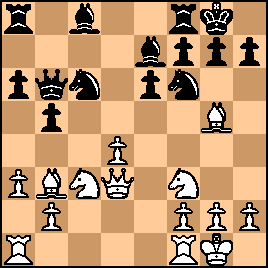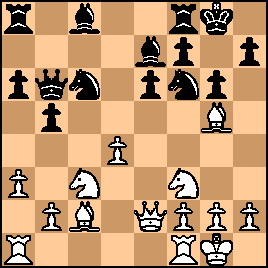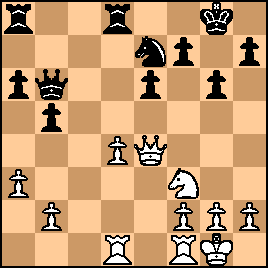KEG: Post II
12... Qb6
This extra attack on the White d4 pawn was unnecessary at this point. The simply 12...was almost certainly best. After 12...Qb6, the position was:

click for larger view13. Bc2
Schlechter should surely either tried either 13. d5 or 13. Ne4. The text creates an obvious threat that gave Pillsbury no trouble at all. 13... g6

click for larger view"Black's defense is a model of what it should be in this opening." (Gunsberg) Perhaps an overstatement, but Pillsbury certainly played well for most of this game. 14. Qe2
Another weak effort by the usually positionally sound Schlechter. 14. Ne5 or 15 Rad1 or 15. Rfd1 were much beter.
After 14. Qe2, the position was:

click for larger view14... Rd8
14...Bby was also good.
As Gunsberg noted, 14...Nxd4? would have been a mistake (though it only loses in his line because of doubtful analysis: giving Gunsberg's line: 14...Nxd4 15. NxN QxN 16. Qf3 16...Rb8? [This does indeed lead to loss. 16...Ra7 was correct after which Black would have a difficult defense but probably should not lose--KEG] 17. Rad1 [17. Rfd1 also wins] Qe5? [bad--but there is nothing all that much better--KEG] 18. Bf4 "and wins." 15. Rad1 Bb7

click for larger viewThis position was the subject of much discussion after the game. 16. Ne4
Pillsbury suggested 16. Be3. This looks good (16...Qc7 17. Rc1 Rac8 and White is very much still in the game, even if arguably slightly worse). Gunsberg considered 16. d5 but conceded that "in the resultant complications Black would have quite held his own." In fact, after 16. d5, Black would be much better, e.g., 16. d5 Nxd5 17. NxN RxN 18. RxR exR 19. Bh6 Bf8 and Black ends up a pawn to the good. The text also led to a poor position for Schlechter, who played this game well below his usual strength: 16... NxN
17. BxB

click for larger viewPillsbury here played, probably reflexively, and probably correctly: 17... NxB
But 17...Nc3 would have been fascinating; e.g., 17...Nc3 18. bxN NxB 19. Ng5 Nd5. 18. BxN BxB
18...Rac8 19. BxB QxB or 18...Bd5 were also decent options. 19. QxB

click for larger view | 




